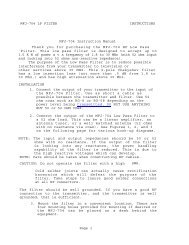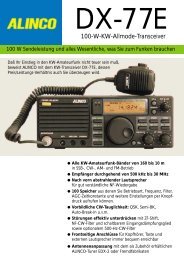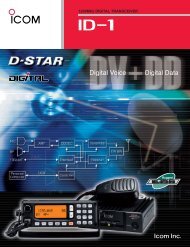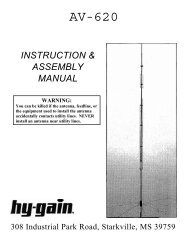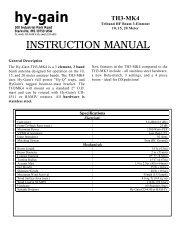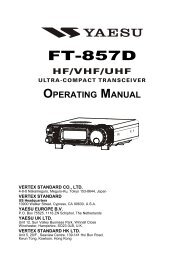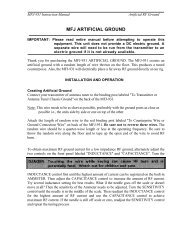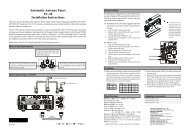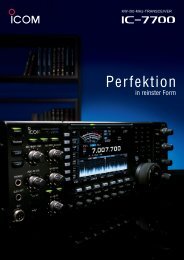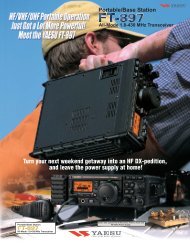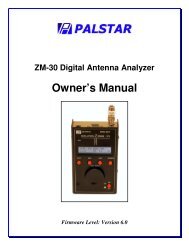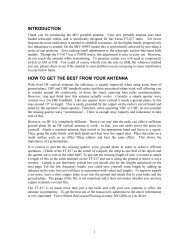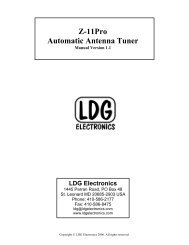AMERITRON AL-82 FULL POWER LINEAR AMPLIFIER - Ad4c.us
AMERITRON AL-82 FULL POWER LINEAR AMPLIFIER - Ad4c.us
AMERITRON AL-82 FULL POWER LINEAR AMPLIFIER - Ad4c.us
You also want an ePaper? Increase the reach of your titles
YUMPU automatically turns print PDFs into web optimized ePapers that Google loves.
LOCATION<br />
Do not operate the Amplifier in excessively warm locations<br />
or near heating vents or radiators. Be sure air can circulate<br />
freely around and through the Amplifier cabinet. Provide an<br />
unobstructed air inlet for the blower. Do NOT place anything<br />
that will impede the free flow of air within 2 inches of the<br />
cabinet ventilation holes.<br />
VENTILATION<br />
The <strong>AL</strong>-<strong>82</strong> ventilation system has been designed and tested<br />
to maintain tube seal temperature safely below the tube<br />
manufacturer's rating at 1500 watts output with a 100% duty<br />
cycle when properly tuned. The blower in the <strong>AL</strong>-<strong>82</strong> is a<br />
permanently lubricated type that requires no maintainence in<br />
normal operation. To insure proper ventilation in your installation,<br />
observe the following:<br />
1. Do not block or unduly restrict the ventilation holes in the<br />
cover. Be sure that the amplifier is located in an area so<br />
the vent holes have open air circulation.<br />
2. The exha<strong>us</strong>t air flow is over 30 CFM. Do not "assist" the<br />
air flow unless the fan exceeds the <strong>AL</strong>-<strong>82</strong> blower CFM<br />
by a factor of 2:1.<br />
3. Do not mount additional fans on the <strong>AL</strong>-<strong>82</strong> cabinet.<br />
4. The exha<strong>us</strong>t air will become quite warm at higher power<br />
levels. Do not place any heat sensitive objects in the<br />
exha<strong>us</strong>t air stream.<br />
INST<strong>AL</strong>LATION Cont.<br />
<strong>POWER</strong> CONNECTIONS<br />
The <strong>AL</strong>-<strong>82</strong> is supplied with a NEMA 6-15P plug for 240V<br />
AC operation. Operation with power main voltages below 200<br />
volt is not 'recommended. A special transformer is required<br />
for 200\/, 50/60 Hz operation (see NOTE on page 1). Refer to<br />
the "Transformer Installation" section on pages 4 and 5 for the<br />
correct wiring for 220 to 240 volt operation.<br />
NEVER REWIRE THE <strong>POWER</strong> SUPPLY TO BOOST THE<br />
HIGH VOLTAGE ABOVE 3700 VOLTS.<br />
The wiring between the f<strong>us</strong>e box and the amplifier AC outlet<br />
m<strong>us</strong>t be No. 12 gauge or larger in order to supply the current<br />
required (13 amperes) without a significant drop in the line<br />
voltage. The outlet should be f<strong>us</strong>ed for 20 amperes.<br />
GROUNDING<br />
TUNING INSTRUCTIONS<br />
Connect a good RF and earth or water pipe ground to the<br />
ground post on the rear panel of the Amplifier. Use the<br />
heaviest and shortest connection possible.<br />
Before you <strong>us</strong>e a water pipe ground, inspect the connections<br />
around the water meter and make sure that no plastic or rubber<br />
hose connections are <strong>us</strong>ed. These connections interrupt<br />
electrical continuity to the water supply line. Install a jumper<br />
around any insulating water connections you may find. Use<br />
heavy copper wire and pipe clamps. It is best to ground all<br />
equipment to one point at the operating position and then<br />
ground this point as described above.<br />
Proper tuning of a grounded grid linear amplifier is best<br />
accomplished with an understanding of what each control<br />
does and v.hat the meters are telling the operator about the<br />
condition of TUNE.<br />
The tuning controls function as follows:<br />
PLATE: This control tunes the amplifier output circuit to the<br />
operating frequency. It should always be adj<strong>us</strong>ted for<br />
maximum output power or maximum grid current. Due to<br />
interaction with the "LOAD" control, a "touch-up'' should be<br />
performed after any load adj<strong>us</strong>tments.<br />
LOAD: This control adj<strong>us</strong>ts the coupling of amplifier to the<br />
antenna or load. It should be adj<strong>us</strong>ted to keep the grid current<br />
in the proper operating range. As the loading capacitance is<br />
reduced (by rotating the control to a higher front panel<br />
number), the coupling is increased. An increase in coupling<br />
will reduce grid current and increase the amount of drive the<br />
amplifier will accept without component damage.<br />
A common mistake in tuning is to adj<strong>us</strong>t the "LOAD" control<br />
at low drive powers and apply more drive dur<br />
ing operation. Excessive grid current, distortion on SSB or<br />
arcing in the tank components occurs when full drive power is<br />
applied to the amplifier without the "LOAD" set far enough<br />
clockwise (higher loading).<br />
It is important to remember the loading m<strong>us</strong>t be set properly<br />
for the PEAK power the amplifier is expected to develop. 50<br />
watts PEP will be the maximum drive the amplifier will safely<br />
handle if the output of the amplifier is tuned with 50 watts of<br />
carrier drive. Any attempt to go beyond the amount of drive<br />
power the amplifier was originally tuned at will result in a<br />
rapid increase in grid current, splatter and even damage to<br />
components.<br />
The "LOAD" control should be adj<strong>us</strong>ted for maximum output<br />
power without exceeding the recommended grid current. DO<br />
NOT USE THE LOAD CONTROL TO REDUCE <strong>POWER</strong><br />
IN A GROUNDED GRID <strong>AMPLIFIER</strong>. The drive from the<br />
exciter should be reduced if the amplifier plate current or<br />
output power is excessive. The "LOAD" setting should be<br />
increased if grid current is excessive. Any errors in adj<strong>us</strong>ting<br />
this control should be made in favor of a higher load setting<br />
(clockwise).



